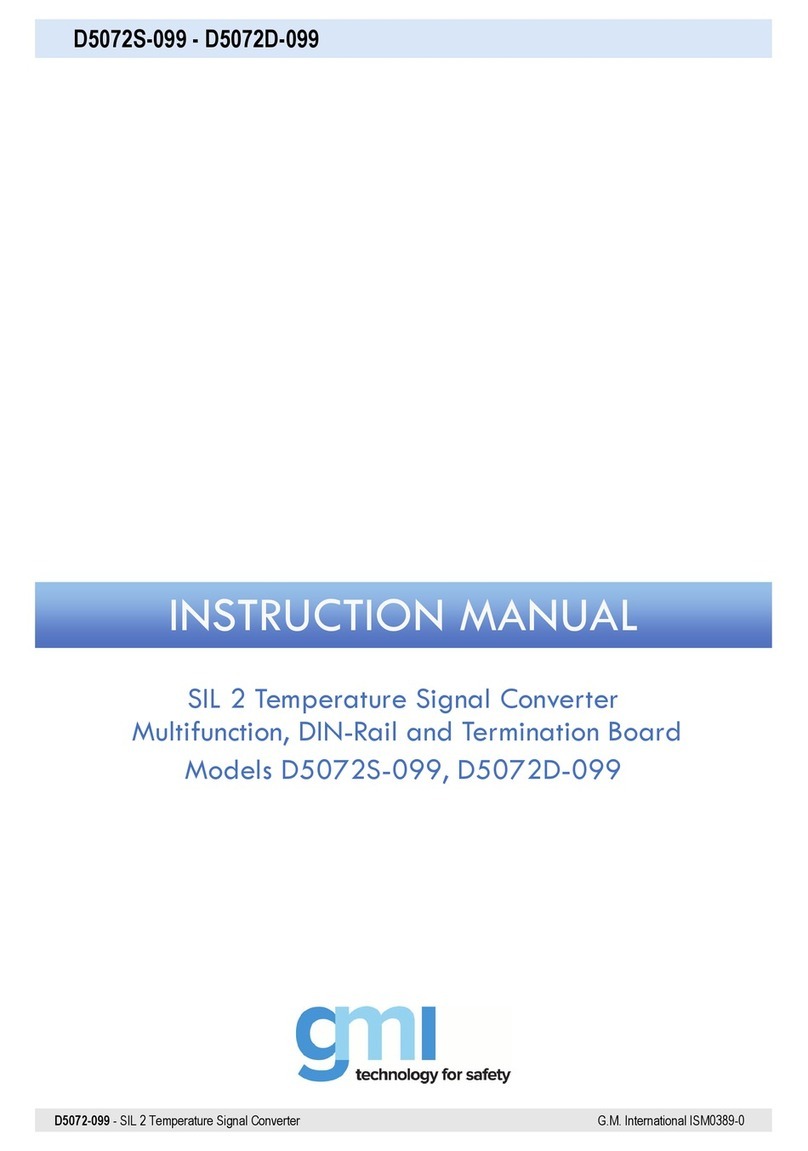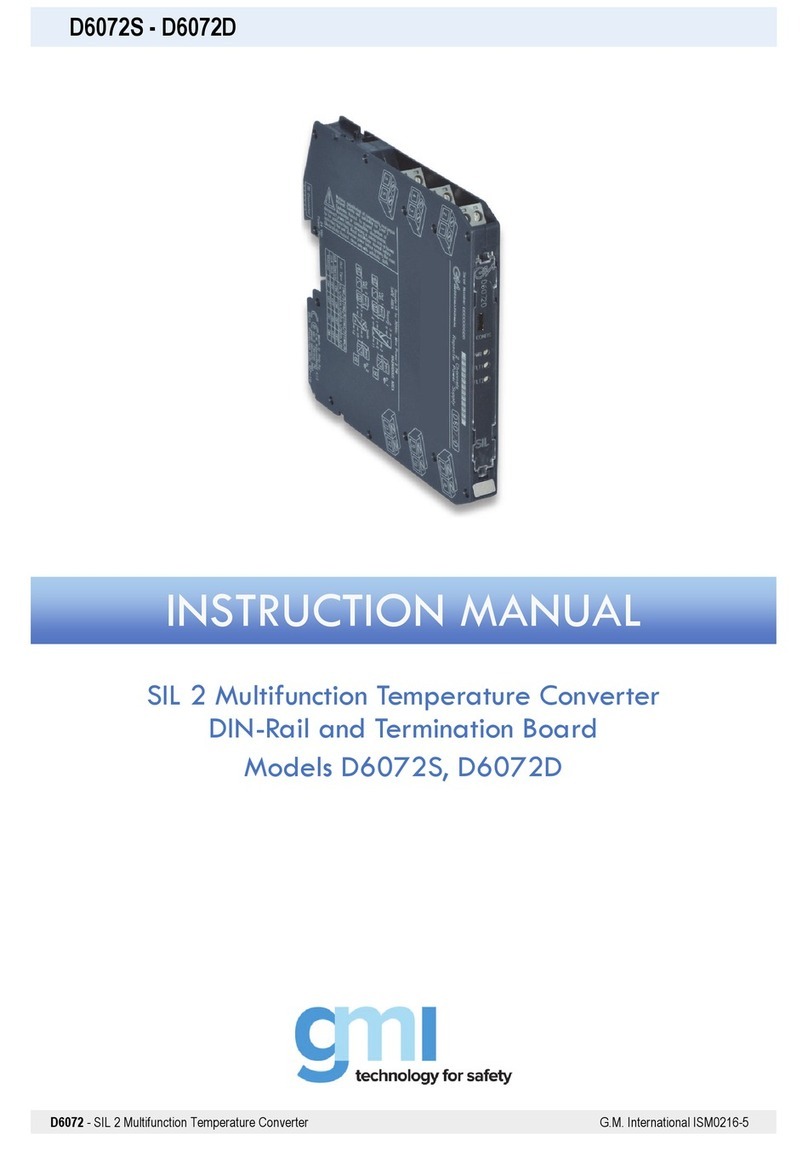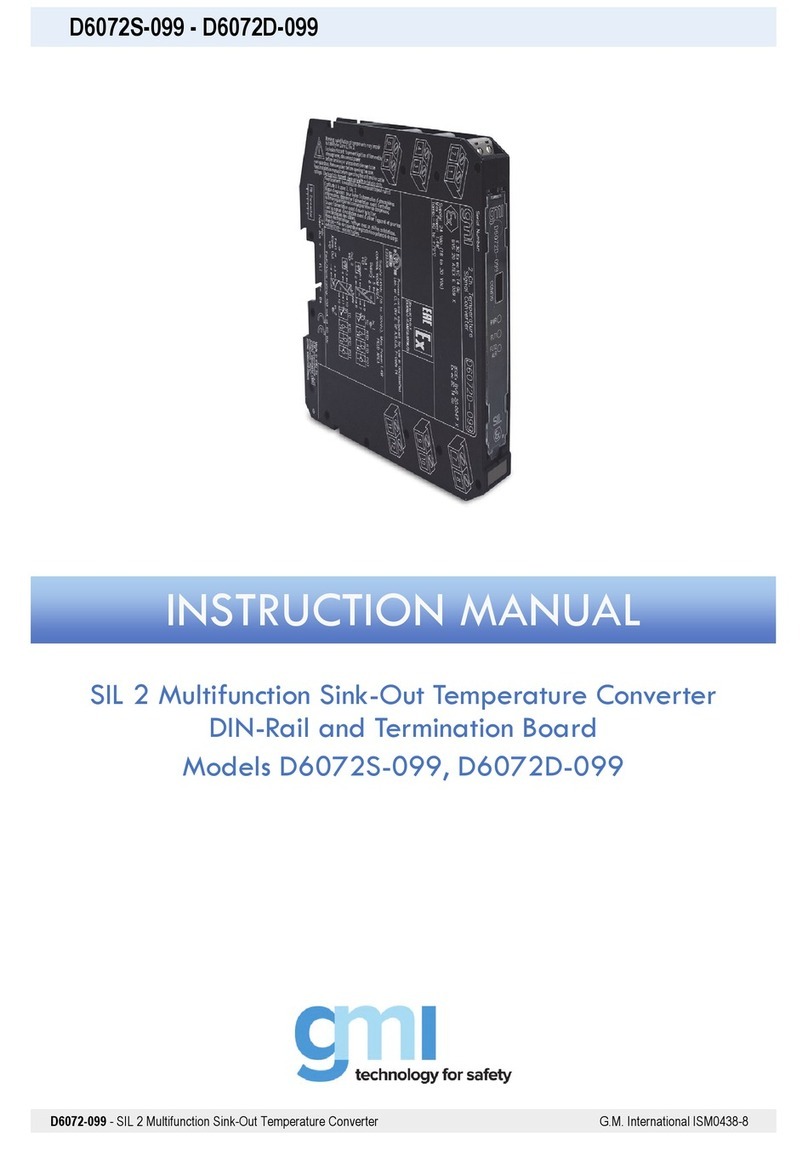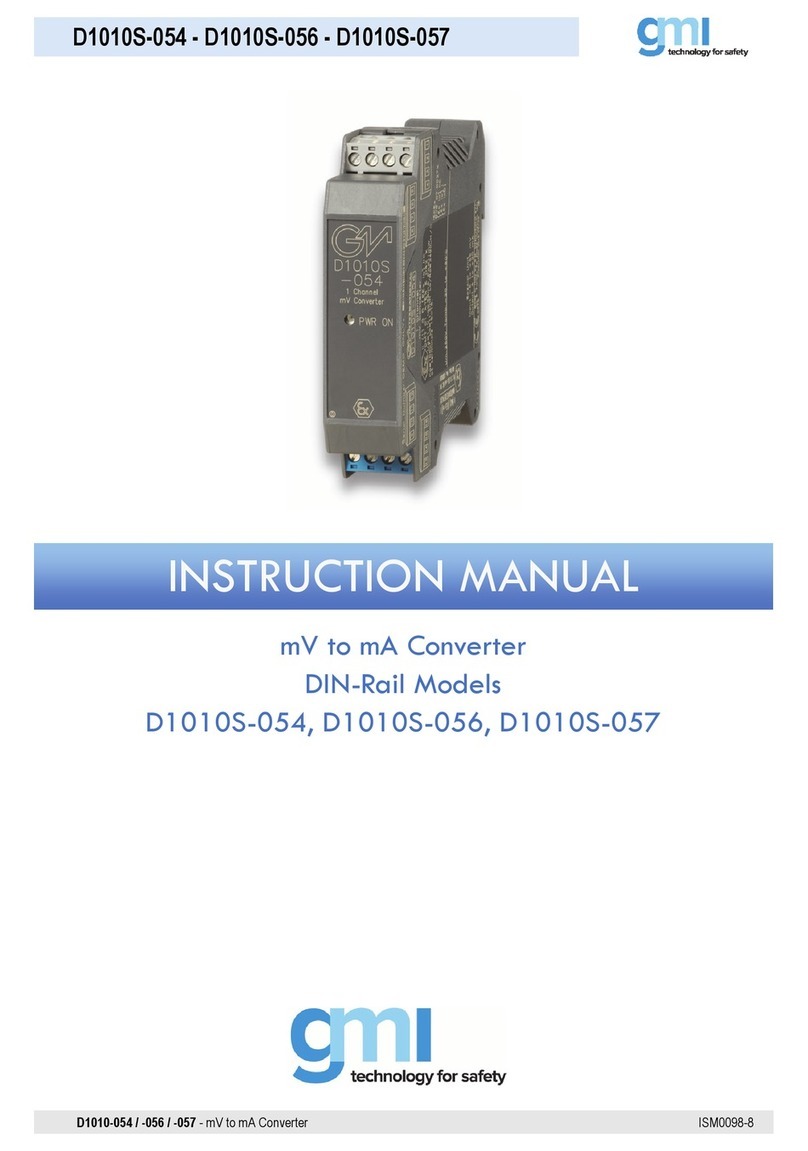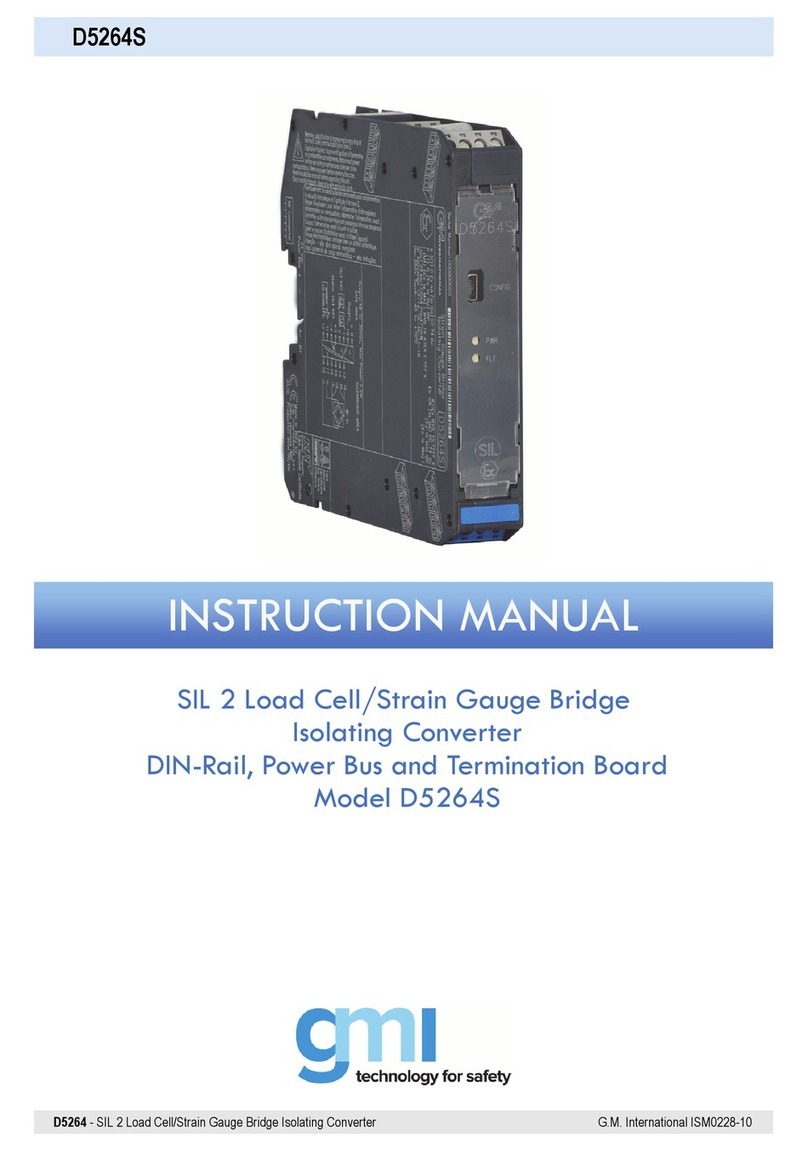
2 D1053 - SIL 2 Analog Signal Converter and Trip Amplifiers G.M. International ISM0016-13
General Description: The single channel DIN Rail Analog Signal Converter and Trip Amplifier D1053S accepts a voltage or current input from externally powered transmitters,
located in Hazardous Area, and converts, with isolation, the signal to drive a Safe Area load. Output signal can be direct or reverse. Two independent Alarm Trip Amplifiers are also
provided. Each alarm energizes, or de-energizes, an SPST relay for high, low, low-startup or burnout alarm functions.
The two alarm relays trip points are settable over the entire input signal range.
Function: 1 channel I.S. input from separately powered transmitters, provides 3 port isolation (input/output/supply) and current (source mode) or voltage output signal.
In addition it provides two SPST relay alarm contacts with adjustable alarm trip point.
Signalling LEDs: Power supply indication (green), alarm A (red), alarm B (red).
Configurability: Totally software configurable, no jumpers or switches, mA or V input/output signal, linear or reverse, alarm trip point, high, low, low-startup or burnout alarm mode,
NE/ND relay operation, hysteresis, delay time, by GM Pocket Portable Configurator PPC1090, powered by the unit or configured by PC via RS-232 serial line with PPC1092 Adapter
and SWC1090 Configurator software.
EMC: Fully compliant with CE marking applicable requirements.
Supply: 24 Vdc nom (20 to 30 Vdc) reverse polarity protected, ripple within voltage limits 5 Vpp.
Current consumption @ 24 V: 65 mA with 20 mA output and relays energized typical.
Power dissipation: 1.5 W with 24 V supply, 20 mA output and relays energized typical.
Max. power consumption: at 30 V supply voltage, overload condition, relays energized and PPC1090 connected, 2.1 W.
Isolation (Test Voltage): I.S. In/Outs 1.5 KV; I.S. In/Supply 1.5 KV; Analog Out/Supply 500 V; Analog Out/Alarm Outs 1.5 KV; Alarm Outs/Supply 1.5 KV; Alarm Out/Alarm Out 1.5 KV.
Input: 0/4 to 20 mA (-4 to +24 mA reading) separately powered input, voltage drop 0.5 V or 0/1 to 5 V or 0/2 to 10 V (-2 to +12 V reading) 1 Mimpedance.
Integration time: 100 ms.
Resolution: 1 µA on current input, 1 mV on voltage input.
Visualization: 1 µA on current input, 1 mV on voltage input.
Input range: -4 to +24 mA on current input, -2 to +12 V on voltage input.
Burnout: enabled or disabled. Analog output can be programmed to detect burnout condition with downscale or highscale forcing.
Alarms can be programmed to detect burnout condition.
Burnout range: low and high separated trip point value programmable between -5 to +25 mA on current input and -3 to +13 V on voltage input.
Output: 0/4 to 20 mA, on max. 600 load source mode, current limited at 22 mA or 0/1 to 5 V or 0/2 to 10 V signal, limited at 11 V.
Resolution: 2 µA current output or 1 mV voltage output.
Transfer characteristic: linear or reverse.
Response time: 50 ms (10 to 90 % step change).
Output ripple: 20 mVrms on 250 load.
Alarm:
Trip point range: within rated limits of input sensor (see input for step resolution).
Delay time: 0 to 1000 s, 100 ms step.
Hysteresis: 0 to 5 mA on current or 0 to 5 V on voltage (see input for step resolution).
Output: voltage free SPST relay contact.
Contact rating: 2 A 250 Vac 500 VA, 2 A 250 Vdc 80 W (resistive load).
Performance: Ref. Conditions 24 V supply, 250 load, 23 ± 1 °C ambient temperature.
Input:
Calibration and linearity accuracy: ± 20 µA on current input or ± 10 mV on voltage input.
Temperature influence: ± 2 µA, 1 mV of input for a 1 °C change.
Analog Output:
Calibration accuracy: ± 0.1 % of full scale.
Linearity error: ± 0.05 % of full scale.
Supply voltage influence: ± 0.05 % of full scale for a min to max supply change.
Load influence: ± 0.05 % of full scale for a 0 to 100 % load resistance change.
Temperature influence: ± 0.01 % on zero and span for a 1 °C change.
Compatibility:
CE mark compliant, conforms to 94/9/EC Atex Directive and to 2004/108/CE EMC Directive.
Environmental conditions: Operating: temperature limits -20 to + 60 °C, relative humidity max 95 %.
Storage: temperature limits – 45 to + 80 °C.
Safety Description:
II (1) G [Ex ia Ga] IIC, II (1) D [Ex ia Da] IIIC, I (M1) [Ex ia Ma] I, II 3G Ex nA IIC T4, [Ex ia Ga] IIC, [Ex ia Da] IIIC, [Ex ia Ma] I associated electrical apparatus.
Uo/Voc = 10.8 V, Io/Isc = 4 mA, Po/Po = 11 mW at terminals 14-15-16.
Ui/Vmax = 30 V, Ci = 4.5 nF, Li = 0 nH at terminals 14-15-16.
Um = 250 Vrms, -20 °C Ta 60°C.
Approvals: DMT 01 ATEX E 042 X conforms to EN60079-0, EN60079-11, EN60079-26, EN61241-0, EN61241-11,
IECEx BVS 07.0027X conforms to IEC60079-0, IEC60079-11, IEC60079-26, IEC61241-0, IEC61241-11, GM International CRR028 conforms to EN60079-0, EN60079-15,
UL & C-UL E222308 conforms to UL913 (Div.1), UL 60079-0 (General, All Zones), UL60079-11 (Intrinsic Safety “i” Zones 0 & 1) for UL and
CSA-C22.2 No.157-92 (Div.1), CSA-E60079-0 (General, All Zones), CSA-E60079-11 (Intrinsic Safety “i” Zones 0 & 1) for C-UL,
refer to control drawing ISM0138 for complete UL and C-UL safety and installation instructions,
FM & FM-C No. 3024643, 3029921C, conforms to Class 3600, 3610, 3611, 3810 and C22.2 No.142, C22.2 No.157, C22.2 No.213, E60079-0, E60079-11, E60079-15,
Russia according to GOST 12.2.007.0-75, R 51330.0-99, R 51330.10-99 [Exia] IIC X, Ukraine according to GOST 12.2.007.0,22782.0,22782.5 Exia IIC X,
EXIDA Report No. GM04/10-27 R003, SIL 2 according to IEC 61508, IEC 61511. Please refer to Functional Safety Manual for SIL applications.
DNV and KR Type Approval Certificate for marine applications.
Mounting: T35 DIN Rail according to EN50022.
Weight: about 160 g.
Connection: by polarized plug-in disconnect screw terminal blocks to accommodate terminations up to 2.5 mm2.
Location: Safe Area/Non Hazardous Locations or Zone 2, Group IIC T4, Class I, Division 2, Groups A, B, C, D Temperature Code T4 and Class I, Zone 2, Group IIC, IIB, IIA
T4 installation.
Protection class: IP 20.
Dimensions: Width 22.5 mm, Depth 99 mm, Height 114.5 mm.
Technical Data
For Safety Related System and SIL2, SIL3 Applications according IEC61508 & IEC61511 Standards refer to “Functional Safety Manual” document number ISM0071
SIL Applications
Characteristics












